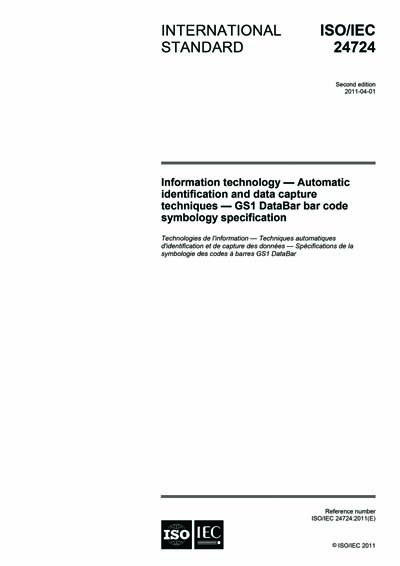Most recent
ISO/IEC 24724:2011
Information technology - Automatic identification and data capture techniques - GS1 DataBar bar code symbology specification
The GS1 DataBar family contains three types of linear symbologies to be used with the GS1 system. The first type has four variations (GS1 DataBar Omnidirectional, GS1 DataBar Truncated, GS1 DataBar Stacked and GS1 DataBar Stacked Omnidirectional). The stacked variations are two-row symbols. The second type comprises only one variation, namely GS1 DataBar Limited. The third type has two variations, a single row variation (GS1 DataBar Expanded) and a multi-row stacked variation (GS1 DataBar Expanded Stacked). The use of GS1 DataBar is intended to comply with the GS1 application guidelines as defined in the GS1 General Specifications.
GS1 DataBar Omnidirectional and GS1 DataBar Stacked Omnidirectional encode a 14-digit GS1 item identification (often referred to as a Global Trade Item Number, or GTIN) in a linear symbol that can be scanned omnidirectionally by suitably programmed point-of-sale scanners. GS1 DataBar Truncated and GS1 DataBar Stacked encode a 14-digit GS1 item identification in a linear symbol and are not suitable for omnidirectional scanning. GS1 DataBar Limited encodes a 14-digit GS1 item identification with a leading digit of zero or one in a linear symbol for use on small items that will not be scanned at the point-of-sale. GS1 DataBar Expanded encodes GS1 item identification plus supplementary application identifier element strings such as weight and "best before" date in a linear symbol that can be scanned omnidirectionally by suitably programmed point-of-sale scanners.
Any member of the GS1 DataBar family can be printed as a stand-alone linear symbol or as part of a GS1 Composite symbol with an accompanying two-dimensional (2D) component printed above the GS1 DataBar linear component.
GS1 DataBar symbols are intended for encoding identification numbers and data supplementary to the identification. The administration of the numbering system by GS1 ensures that identification codes assigned to particular items are unique worldwide and that they and the associated supplementary data are defined in a consistent way. The major benefit for the users of the GS1 system is the availability of uniquely defined identification codes and supplementary data formats for use in their trading transactions.
ISO/IEC 24724:2011 defines the requirements for the GS1 DataBar symbology family. It specifies the characteristics of the GS1 DataBar symbology family, data character encodation, symbol formats, dimensions, print quality requirements, error detection, and decoding algorithms.
For GS1 Composite symbols, ISO/IEC 24723 defines the 2D component.
GS1 DataBar was formerly known as "Reduced Space Symbology (RSS)" and is renamed to align with the name of the GS1 organization.
Content Provider
International Organization for Standardization [iso]






